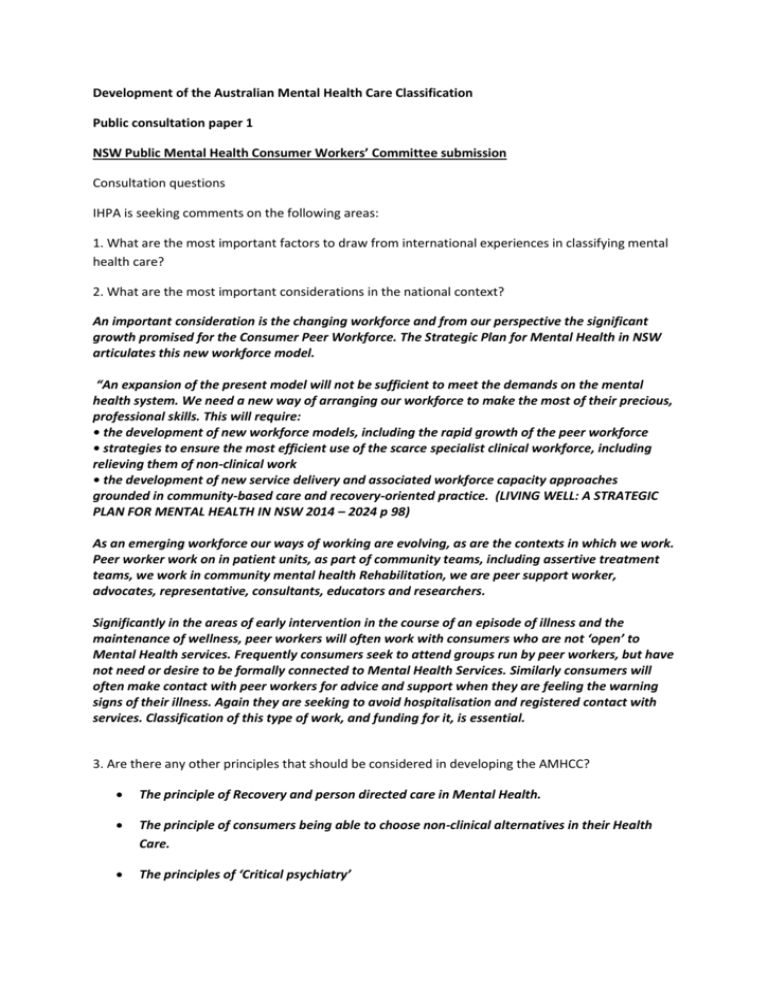Development of the Australian Mental Health Care Classification
advertisement

Development of the Australian Mental Health Care Classification Public consultation paper 1 NSW Public Mental Health Consumer Workers’ Committee submission Consultation questions IHPA is seeking comments on the following areas: 1. What are the most important factors to draw from international experiences in classifying mental health care? 2. What are the most important considerations in the national context? An important consideration is the changing workforce and from our perspective the significant growth promised for the Consumer Peer Workforce. The Strategic Plan for Mental Health in NSW articulates this new workforce model. “An expansion of the present model will not be sufficient to meet the demands on the mental health system. We need a new way of arranging our workforce to make the most of their precious, professional skills. This will require: • the development of new workforce models, including the rapid growth of the peer workforce • strategies to ensure the most efficient use of the scarce specialist clinical workforce, including relieving them of non-clinical work • the development of new service delivery and associated workforce capacity approaches grounded in community-based care and recovery-oriented practice. (LIVING WELL: A STRATEGIC PLAN FOR MENTAL HEALTH IN NSW 2014 – 2024 p 98) As an emerging workforce our ways of working are evolving, as are the contexts in which we work. Peer worker work on in patient units, as part of community teams, including assertive treatment teams, we work in community mental health Rehabilitation, we are peer support worker, advocates, representative, consultants, educators and researchers. Significantly in the areas of early intervention in the course of an episode of illness and the maintenance of wellness, peer workers will often work with consumers who are not ‘open’ to Mental Health services. Frequently consumers seek to attend groups run by peer workers, but have not need or desire to be formally connected to Mental Health Services. Similarly consumers will often make contact with peer workers for advice and support when they are feeling the warning signs of their illness. Again they are seeking to avoid hospitalisation and registered contact with services. Classification of this type of work, and funding for it, is essential. 3. Are there any other principles that should be considered in developing the AMHCC? The principle of Recovery and person directed care in Mental Health. The principle of consumers being able to choose non-clinical alternatives in their Health Care. The principles of ‘Critical psychiatry’ Is this the least restrictive care for this episode? Modern-day relies too much on the "medical model" and emphasises diagnostic decisions. If psychiatrists adopted a more social or therapeutic community approach treatments would be more effective. The categorisation of psychiatric illness is not as clear as most psychiatrists believe. Assessment of aetiology too often fails to take personal and social factors into account. There is too much emphasis on the scientific possibilities of randomised controlled trials. The evidence of these trials is biased. (CPD Bulletin Psychiatry (2000) 2 33-36) ’ 4. Are there further data or other limitations of which the AMHCC should be aware? 5. Are there any other key considerations that should be taken into account in developing the AMHCC? Recovery-oriented, trauma informed and person-centred and directed care must be central. 6. Are there other cost drivers that should be considered in the development of the AMHCC? The MH Consumers choice as to where funding is spent. 7. Are there any further considerations in relation to the proposed architecture? 8. Is there any further evidence that should be considered in testing the proposed architecture? 9. Which psychological interventions, if any, may be of significant in understanding the cost of care? Access to affordable psychological services at all stages of care. 10. Are there particular aspects or areas of the AMHCC that should be prioritised in its development, or aspects that should be developed at a later stage? Emerging workforces in Mental health – Peer, Aboriginal, hybrid roles across agencies (FACS – Housing Mental Health 11. Are there any further considerations that should be taken into account when developing the AMHCC? Representation of Consumers and Consumer Peer Workers at all stages of consultation, modelling and implementation.








